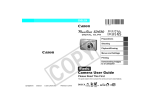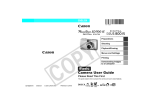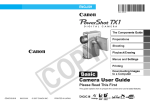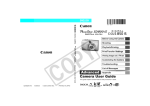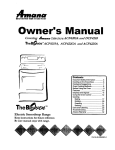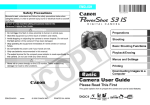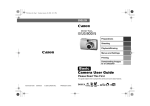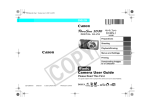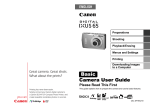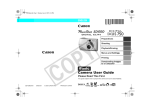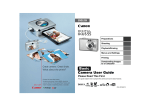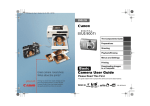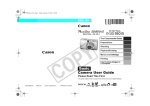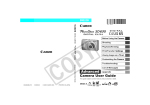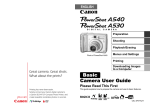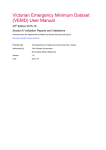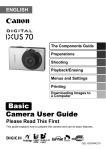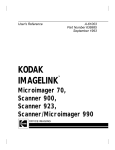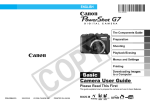Download Canon PowerShot SD40 User's Manual
Transcript
ENGLISH The Components Guide Preparations Shooting Playback/Erasing Menus and Settings Printing Downloading Images to a Computer Basic Camera User Guide Please Read This First This guide explains how to prepare the camera and use its basic features. CDI-E297-010 XX06XXX © 2006 CANON INC. PRINTED IN JAPAN Flowchart and Reference Guides The following guides are available. Refer to them as necessary according to the flowchart below. For information on included items and items sold separately System Map The Components Guide Preparations • Installing and charging the battery • Installing the memory card • Setting the date, time and language Basic Camera User Guide (This Guide) • Read this first. Shooting Playback/Erasing Menus and Settings Handling precautions, references to the various shooting and playback functions Printing • Installing the software • Downloading images to a computer • Using the software Advanced Camera User Guide Direct Print User Guide Basic Camera User Guide (This Guide) Software Starter Guide ZoomBrowser EX/ ImageBrowser Software User Guide • PDF manuals available on the Canon website. http://web.canon.jp/ Imaging/information-e.html In this guide, the Basic Camera User Guide is called the Basic Guide, and the Advanced Camera User Guide is called the Advanced Guide. Also, "battery" refers to the battery pack. 7 The Components Guide Front View The Components Guide Attaching the Wrist Strap* Wrist Strap Mount Speaker AF-assist Beam (Advanced Guide p. 24) Red-Eye Reduction Lamp (Advanced Guide p. 32) Self-Timer Lamp (p. 18) Flash (p. 16) Microphone (Advanced Guide pp. 40, 80) Lens * When carrying the camera by the strap, be careful not to swing the camera or catch it on other items. 1 Back View LCD Monitor (Advanced Guide pp. 12, 14) Tripod Socket Camera Station Connector Memory Card Slot/Battery Cover (p. 10) 2 Controls The Components Guide Mode Switch (pp. 12, 13) Power Button (p. 12) Shutter Button (p. 12) (Print/Share) Button (pp. 23, 31, Advanced Guide p. 37) Indicator (p. 7) FUNC./SET (Function/Set) Button (p. 21, Advanced Guide p. 22) MENU Button (p. 22, Advanced Guide p. 23) (Macro)/ Button (p. 17) (Shooting: Telephoto/Playback: Magnify)/ Button (p. 16, Advanced Guide p. 67) (Flash)/ Button (p. 16) (Shooting: Wide Angle)/ (Single Image Erase)/ Button (pp. 16, 20) 3 Camera Station You can do the following when the camera is placed in the camera station. • Charge the battery (Compact Power Adapter CA-DC20/CA-DC20E is required) • Play back and erase • Connect to a TV and play back • Connect to a printer and print • Connect to a computer and download You can operate the camera with the wireless controller (p. 6) or the camera buttons. DIGITAL Terminal (p. 28) DC IN Terminal (Power Input) (p. 9) A/V OUT (Audio/Video output) Terminal (Advanced Guide p. 97) Connector Cover (p. 9) Camera Connector Charge Indicator (p. 9) Remote Control Sensor (p. 7) 4 • Always put the connector cover back on the camera connector when the camera station is being carried or not in use. •The bottom of the camera station has non-slip rubber feet. - The rubber feet are covered with a thin orange plastic film. Carefully peel the film off before use. - If dirt adheres to the rubber feet, lightly wipe them with a slightly dampened cloth. The Components Guide • Always turn off the camera power before placing the camera in the camera station or removing it. Placing or removing the camera with the power on will abruptly turn the camera off. • When the camera is turned on in the camera station, it will always start up in the playback mode regardless of the setting selected with the mode switch. • Compact Power Adapter CA-DC20/CA-DC20E is recommended for powering the camera when the camera is used in the camera station. 5 Using the Wireless Controller Installing the Battery Install the lithium coin battery (CR2025) before using the wireless controller. Be particularly careful to keep the lithium coin battery out of the reach of children. Seek medical assistance immediately if a child swallows a battery since corrosive battery fluids could damage the stomach or intestinal wall. 1. Slip a fingernail into ( ) and press in the direction of the arrow while slipping another fingernail into ( ) and removing the battery holder. 2. Place the battery in the holder with the "+" side up and replace the holder. Removing the Battery Pull the battery out in the direction of the arrow. Operating the Wireless Controller When the camera is placed in the camera station, you can use the wireless controller to perform the following operations with the camera. • Play back, Erase • Play back images when connected to a TV • Print images when connected to a printer • Download images when connected to a computer 6 Remote Control Sensor Transmitter Pressing this button toggles between transferring to a computer and playing back on the LCD monitor. The information display mode advances (Standard— Detailed—Off) each time you press this button. The distance at which the wireless controller can be used will shorten under the following circumstances. • When operated at an angle to the remote control sensor • When strong light strikes the remote control sensor • When the wireless controller battery is weak • When used outside The Components Guide Other than the operations listed above, all of the buttons perform the same functions as the corresponding buttons on the camera. However, functions requiring the user to press two buttons at the same time can only be performed with the camera. Indicator The camera indicator lights or blinks under the following circumstances. Never do the following while an indicator is blinking green. These actions may corrupt image data. • Shake or jolt the camera • Shut off the power, or open the memory card slot/battery cover Green: Ready to shoot /connected to a computer/display off (Advanced Guide p. 26) Blinking Green: Camera starting up/image recording/reading/erasing/transferring (when connected to a computer) Orange: Ready to shoot (flash on) Blinking Orange: Ready to shoot (camera shake warning) *Camera beeps once if difficult to focus. 7 Preparations 1. Installing the Battery. 1. Slide the memory card slot/battery cover and open it ( , ). 2. Push the battery lock in the direction of the arrow ( ), align the symbol on the battery and inside of the memory card slot/battery cover and insert the battery until it locks into place ( ). To remove the battery, push the battery lock in the direction of the arrow ( ) and hold it while pulling the battery out. Battery Lock symbol 3. Close the memory card slot/battery cover. 2. Charging the Battery. Charge the battery before use under the following circumstances. • When using the battery for the first time. • When the "Change the battery pack" message displays. 8 1. Connect the compact power adapter's DC plug to the DC IN terminal of the camera station. Ensure that the symbol on the DC plug is on the top and align it with the symbol on the camera station. 2. (For CA-DC20) Draw out the compact power adapter's power plug ( ) and plug it into a power outlet ( ). (For CA-DC20E) Attach the power cord and plug the other end into a power outlet. CA-DC20 CA-DC20E Preparations 3. Remove the connector cover from the camera station. 4. Place the camera securely into the camera station. • Do not turn on the camera. • The charge indicator will light orange while the battery in the camera is charging. It will change to green when the charge is complete. Charging takes approximately 1 hour 30 minutes. • After the charge is complete, remove the camera from the camera station as soon as possible. Charge Indicator To protect the battery and prolong its life, do not charge it for longer than 24 hours continuously. Î See the Advanced Guide: Battery Handling (p. 115). Î See Camera Station (p. 4). 9 3. Inserting the Memory Card. 1. Slide the memory card slot/battery cover and open it. 2. Insert the memory card until it clicks into place. 3. Close the memory card slot/battery cover. Front Ensure that the memory card is correctly oriented before inserting it in the camera. Inserting it backward may cause the camera to fail to recognize the memory card or to malfunction. Î See the Advanced Guide: Handling the Memory Card (p. 117). Î See the Advanced Guide: Formatting Memory Cards (p. 29). To Remove the Memory Card Use a finger to push the memory card in until you hear a click, then release it. You can use SD memory cards, SDHC memory cards and MultiMediaCards with this camera. These cards are collectively called memory cards in this guide. 10 First Time Settings Setting the Date/Time • A rechargeable lithium battery is built into the camera to save such settings as the date/time. This battery charges when the main battery is in the camera. When you purchase the camera, place the main battery in it for approximately four hours to charge the lithium battery. It will charge even if the camera is turned off. • The date/time settings may be lost after approximately three weeks if you remove the main battery. Reset the date/time settings if this occurs. Preparations 1. Press the power button ( ). 2. Use the or button to select an item and the or button to change its value ( ). To set the daylight saving option, select the icon and use the or button to configure the setting. 3. Confirm that the correct time is displayed and press the FUNC./SET button ( ). The date and time can also be set in the Set up menu (p. 22). Î See the Advanced Guide: Setting the World Clock (p. 20). Setting the Display Language 1. Slide the mode switch to (playback). 2. Hold down the FUNC./SET button and press the MENU button. 3. Use the , , or button to select a language and press the FUNC./SET button. The display language can also be set in the Set up menu (p. 22). 11 Shooting 1. Press the power button. Power button The start-up sound will play and the start-up image will display in the LCD monitor. • Pressing the power button again turns the power off. • To switch to the setting that mutes all sounds (except for the warning sound), press and hold the MENU button while pressing the power button. Î See the Advanced Guide: Using the LCD Monitor (p. 12). Î See the Advanced Guide: Power Saving Function (p. 19). Î See the Advanced Guide: Set up Menu (p. 26). Î See the Advanced Guide: My Camera Menu (p. 28). 2. Set the shooting mode to (Auto). 1. Slide the mode switch to (Rec.) ( ). 2. Press the FUNC./SET button ( ) and use the or button ( ) to select (Auto). 3. Press the FUNC./SET button ( ). 3. Aim the camera at the subject. 4. Focus and shoot. 1. Press the shutter button halfway to focus. When the camera focuses, it beeps Indicator twice and the indicator lights green (orange when the flash fires). In addition, a green AF frame appears in the LCD monitor on the portion of the image used to set the focus. 12 2. Press the shutter button fully to shoot. The shutter sound will play and You can use this as a shutter button with the camera held vertically. the image will record. The (See the Advanced Guide: Shooting Vertically indicator will blink green while (Vertical Shutter Release) (p. 37).) the image is recorded to the memory card. Î See Indicator (p. 7). the Advanced Guide for the various shooting methods Î See available. Reviewing an Image Right After Shooting Î See the Advanced Guide: Review (p. 24). Shooting After a shot is taken, the image appears in the LCD monitor for approximately 2 seconds. You can continue to display images regardless of the review duration setting with the following procedures. • Keeping the shutter button pressed after a shot. • Pressing the FUNC./SET button while the image is displayed in the LCD monitor. To stop displaying the image, press the shutter button halfway. Î See Erasing (p. 20). Selecting a Shooting Mode 1. Slide the mode switch to (Rec.) or 2. Press the FUNC./SET button (Movie) ( ). ( ) and use the or button ( ) to select the shooting mode. For a scene mode (p. 14), select the (default setting) and press the MENU button to select the desired mode. 3. Press the FUNC./SET button ( ). 13 Shooting Modes Still Images Auto The camera automatically selects settings. Manual Allows you to select settings yourself, such as the exposure compensation, white balance, my colors or ISO speed. Stitch Assist Allows you to shoot overlapping images that can later be merged (stitched) to create one panoramic image on a computer. Select [Stitch Assist] from the [ (Rec.)] menu. Î See the Advanced Guide (p. 42). Portrait Produces a soft effect when photographing people. Landscape You can shoot wide, expansive scenes. Night Snapshot Allows you to take snapshots of people against twilight or night backgrounds by reducing the effects of camera shake even without using a tripod. Color Accent Use this option to have only the color specified in the LCD monitor remain and to transform all others to black and white. Î See the Advanced Guide (p. 56). Color Swap Use this option to transform a color specified in the LCD monitor into another. Î See the Advanced Guide (p. 58). Scene Mode By simply selecting one of the following shooting modes, you can shoot with the most appropriate settings for the scene. Kids&Pets Allows you to capture subjects that move around, such as children and pets, without missing photo opportunities. Foliage Shoots trees and leaves—such as new growth, autumn leaves or blossoms—in vivid colors. 14 Indoor Prevents camera shake and maintains the subject's true color when shooting under fluorescent or tungsten lighting. Snow Shoots without a blue tinge and without making people appear dark against a snowy background. Fireworks Beach Shoots without making people appear dark near water or sand where reflected sunlight is strong. Captures fireworks in the sky sharply and at optimal exposure. Aquarium Selects the optimal ISO speed, white balance and color balance to capture fish and other items in an indoor aquarium. Underwater Appropriate for shooting images with All Weather Case AW-DC40 (sold separately). This mode uses an optimal white balance setting to reduce bluish tones and record images with a natural hue. Movie Movie • The shutter speed is slow in mode. Always use a tripod to avoid camera shake. • In , , , , , or mode, the ISO speed may increase and cause noise in the image depending on the scene being shot. • In mode, shoot with the subject 1 m (3.3 ft.) or more from the end of the lens. Shooting Shoots a movie when you press the shutter button. You can select from the following modes: [ Standard]; [ Fast Frame Rate] suitable for sports or fast motion; [ Compact] convenient for email attachments; [ Color Accent] for recording all colors in black and white except for the selected color; and [ Color Swap] for recording a selected color as a different color. Î See the Advanced Guide (p. 38). • To shoot underwater, install the camera in All Weather Case AW-DC40 (sold separately). • We recommend you use All Weather Case AW-DC40 for shooting at ski resorts or beaches. 15 Using the Zoom 1. Press the or button. The zoom can be adjusted from 38 – 90 mm (focal length) in 35mm film equivalent terms. Telephoto: Zooms in on the subject. Wide Angle: Zooms out from the subject. Using the Flash 1. Press the button ( ) and use the switch between modes ( ). or button to Auto On Off Î See the Advanced Guide: Red-Eye Reduction Function (p. 32). Î See the Advanced Guide: Setting the Slow Synchro Function (p. 32). You are recommended to shoot with the camera attached to a tripod or other device if the camera shake warning icon appears. The option cannot be set in (Auto) mode. Î See the Advanced Guide: Functions Available in Each Shooting Mode (p. 144). Î See Selecting a Shooting Mode (p. 13). 16 Shooting Close-Ups 1. Press the button. • This records flowers and other small objects large and up close. • The allowable shooting distances will display on the LCD monitor for approximately 2 seconds. The LCD monitor will also display the same information when zooming in Macro mode. To Cancel: press the button and use the or button to display . Shooting Image Area at Minimum Shooting Distance from End of Lens to Subject • Maximum wide angle setting: 284 × 210 mm (11 × 8.3 in.) Minimum shooting distance: 30 cm (12 in.) • Maximum telephoto setting: 43 × 32 mm (1.7 × 1.3 in.) Minimum shooting distance: 10 cm (3.9 in.) The exposure may not be optimal when the flash is used in macro mode. This setting cannot be used in some shooting modes. Î See the Advanced Guide: Functions Available in Each Shooting Mode (p. 144). Î See Selecting a Shooting Mode (p. 13). 17 Using the Self-Timer 1. Press the FUNC./SET button ( button to select ) and use the * (Drive Mode) ( ). or *Default setting 2. Use the or button to select either and press the FUNC./SET button ( ). , or ( ) • You can change the delay time and number of shots with the option (p. 19). • When the shutter button is pressed fully, the self-timer will activate and the self-timer lamp will blink (when using red-eye reduction, it will stay lit for the last 2 seconds). To Cancel: Select in Step 2 and press the FUNC./SET button. 10 sec. Self-Timer: shoots 10 sec. after you press the shutter button. • 2 sec. before the shutter releases, the self-timer lamp and sound speed up*1. 2 sec. Self-Timer: shoots 2 sec. after you press the shutter button. • The self-timer sound beeps quickly*1 when you press the shutter button and the shutter releases 2 sec. later. Custom Timer: you can change the delay time (0–10*2, 15, 20, 30 sec.) and number of shots (1–10*3). • When [Delay] is set to 2 or more sec., the self-timer sound begins to beep 2 sec. before the shutter releases. When [Shots] is set to more than 1, the self-timer sound only beeps before the first shot. *1 This may differ depending on your My Camera settings (Advanced Guide p. 98). *2 Default setting. *3 Default setting is 3 shots. The self-timer cannot be used in some shooting modes. Î See the Advanced Guide: Functions Available in Each Shooting Mode (p. 144). Î See Selecting a Shooting Mode (p. 13). 18 Changing the Delay Time and Number of Shots ( 1. In the FUNC. menu, select and press the MENU button. ) Î See Menus and Settings (p. 21). 2. Use the or button to select [Delay] or [Shots] and the or button to change the setting and press the FUNC./SET button. If the [Shots] option is set to 2 or more shots, the following occurs. • The exposure and white balance are locked at the settings selected for the first shot. • If the flash is used, the interval between shots lengthens because the flash must charge. ory of the camera fills. • Shooting will automatically cease if the memory card becomes full. Shooting • The interval between shots lengthens when the built-in mem- 19 Playback 1. Slide the mode switch to (playback) ( ). The last image that was played back appears (Resume Playback). If additional images were shot after viewing images in playback mode, the last image that was shot will appear instead. If the memory card has been switched, or the images on the memory card have been edited with a computer, the newest image on the memory card appears. 2. Use the view ( or button to display the image you wish to ). Use the button to move to the previous image and the button to move the next image. Holding the button down advances the images more rapidly, but shows them less clearly. Î See the Advanced Guide for the various playback methods available Erasing 1. In the playback mode, use the or button to select an image to erase ( ) and press the button ( ). 2. Confirm that [Erase] is selected and press the FUNC./SET button ( ). To exit instead of erasing, select [Cancel]. Please note that erased images cannot be recovered. Exercise adequate caution before erasing an image. Î See the Advanced Guide: Erasing Images (p. 89). When you place the camera in the camera station, you can operate the camera with the wireless controller for playing back or erasing images (p. 6) . 20 Menus and Settings Settings for the shooting or playback modes or such camera settings as the print settings, date/time and sounds are set using the FUNC. menu or the Rec., Play, Print, Set up or My Camera menu. FUNC. Menu This menu sets many of the common shooting functions. Playback/Erasing This example shows the FUNC. menu in (Auto) mode. Menus and Settings Slide the mode switch to or . Press the FUNC./SET button. Use the or button to select a menu item. • Some items may not be selectable in some shooting modes. Use the or button to select an option for the menu item. • You can select further options with the MENU button for some options. • After selecting an option, you can press the shutter button to shoot immediately. After shooting, this menu will appear again, allowing you to adjust the settings easily. Press the FUNC./SET button. Î See the Advanced Guide: Menu List (p. 24). 21 Rec., Play, Print, Set up and My Camera Menus Convenient settings for shooting, playback or printing can be set with these menus. (Rec.) Menu (Set up) Menu (My Camera) Menu You can switch between menus with the or button when this part is selected. • This example shows the Rec. menu in (Auto) mode. • In playback mode, the Play, Print, Set up and My Camera menus display. Press the MENU button. Use the or button to switch between menus. Use the or button to select a menu item. • Some items may not be selectable in some shooting modes. Use the or button to select an option. • Menu items followed by an ellipsis (...) can only be set after pressing the FUNC./SET button to display the next menu. Press the FUNC./SET button again to confirm the setting. Press the MENU button. Î See the Advanced Guide: Menu List (p. 24). 22 Printing You can easily print by connecting the camera station to a direct print button compatible printer*1 with a cable and simply pressing the on the camera or wireless controller. 1. Set the camera securely into the camera station. 2. Connect the camera station to a Direct Print compatible printer and turn on the printer's power. You can also connect the camera to a TV (Advanced Guide p. 97) and check the images on the TV while printing. Canon Brand Printers Camera AV Cable SELPHY CP Series Compact Photo Printers*2 Interface Cable Camera Station PIXMA Series/SELPHY DS Series Bubble Jet Printers 3. Turn on the camera's power and confirm that ( , or is displayed in the upper left of the LCD monitor ). Printing *1 Since this camera uses a standard protocol (PictBridge), you can use it with other PictBridge-compliant printers in addition to Canon-brand printers. *2 You can also use card photo printers such as the CP-10/CP-100/CP-200/CP-300. • The camera's button will light blue. • The displayed icon will vary according to the printer model. • will display in the movie mode. 23 4. Use the or button to select an image to print ( and press the camera's or the wireless controller's button ( ). The camera's ) button will blink blue and printing will start. Î See the Advanced Guide: Setting the DPOF Print Settings (p. 91). Î See the Direct Print User Guide. Î See the user guide for your printer. Î See Using the Wireless Controller (p. 6). 24 Downloading Images to a Computer The following methods can be used to download images recorded by the camera to a computer. Some methods, depending on the OS used, may not be available. Please read System Requirements (p. 26) in advance. Camera to Computer Connection Supplied Software Install It Do Not Install It Camera Procedure Computer Procedure z z – Windows Me z z Windows 2000 z z z z z z – – Downloading Method OS Windows 98 Second Edition (SE) Windows XP Mac OS X Computer System Requirements z z •Basic Guide (p. 26) •Software Starter Guide Connecting the Camera to •Basic Guide (p. 28) a Computer Downloading Images to •Basic Guide (pp. 29–30) a Computer •Software Starter Guide •Windows® XP and Mac OS X Users leaflet Downloading Images to a Computer Computer Procedure Using a Memory Card Reader A memory card reader can be used with all the operating systems listed above. See the Software Starter Guide for details. 25 System Requirements Please install the software on a computer meeting the following minimum requirements. Windows OS Windows 98 Second Edition (SE) Windows Me Windows 2000 Service Pack 4 Windows XP (including Service Pack 1 and Service Pack 2) Computer Model The above OS should be pre-installed on computers with built-in USB ports. CPU Pentium 500 MHz or higher processor RAM Windows 98 SE/Windows Me Windows 2000/Windows XP Interface USB Free Hard Disk Space • Canon Utilities - ZoomBrowser EX - PhotoStitch • Canon Camera TWAIN Driver • Canon Camera WIA Driver Display 1,024 x 768 pixels/High Color (16 bit) or better 128 MB or more 256 MB or more 200 MB or more 40 MB or more 25 MB or more 25 MB or more Macintosh OS Mac OS X (v10.2–v10.4) Computer Model The above OS should be pre-installed on computers with built-in USB ports. CPU PowerPC G3/G4/G5 or Intel Processor* RAM 256 MB or more Interface USB Free Hard Disk Space • Canon Utilities - ImageBrowser - PhotoStitch Display 1,024 x 768 pixels/32,000 Colors or better 200 MB or more 40 MB or more * EOS Utility (software for EOS DIGITAL series cameras) is only supported by PowerPC. 26 Preparing to Download Images Ensure that you install the software first before connecting the camera to the computer. Items to Prepare • Camera and computer • Camera station (wireless controller) • Canon Digital Camera Solution Disk supplied with the camera • Interface cable supplied with the camera 1. Install the software. 1. Place the Canon Digital Camera Solution Disk in the computer's CD-ROM drive. 2. Click [Easy Installation]. Select [Easy Installation] as the setup type and click [Next]. Proceed with the installation while reviewing installation settings. Downloading Images to a Computer Double-click the [Canon Digital Camera Installer] icon in the CD-ROM window. When the installer panel appears, click [Install]. 3. When the installation is finished, the [Finish] or [Restart] button appears. Click the one that appears. When the installation is finished, click [Exit]. 4. When the screen returns to the desktop display, remove the Canon Digital Camera Solution Disk from the CD-ROM drive. 27 2. Connecting the camera to a computer. 1. Connect the supplied interface cable to the computer's USB port and to the DIGITAL terminal on the camera station. USB Port Interface Cable DIGITAL Terminal Interface Cable 2. Slide the camera's mode switch to (playback), place it securely in the camera station and turn on its power. The camera and computer will be able to communicate. Always grasp the sides of the connector when disconnecting the interface cable from the camera station's DIGITAL terminal. If the Digital Signature Not Found window appears, click [Yes]. The USB driver will automatically finish installing onto the computer when you attach the camera and open a connection. 28 Downloading Images to a Computer A window allowing you to set the preferences will appear when a connection is established between the camera and computer. 1. Select [Canon CameraWindow] and click [OK] (first time only). 2. Download the images. • Download the images using the camera or the computer. • By default, the downloaded images are saved into the [My Pictures] folder. Downloading Images Using the Camera (p. 31). Downloading Images Using a Computer. By default, all images that have yet to be downloaded will download. Downloading Images to a Computer If the window to the right does not appear, click the [Start] menu and select [All Programs] or [Programs], followed by [Canon Utilities], [CameraWindow], [PowerShot IXY - IXUS - DV 6] and [CameraWindow]. You can set the type of image to download and the destination folder. Thumbnails (small versions) of the downloaded images will display in the ZoomBrowser EX Main Window. By default, the downloaded images are saved into subfolders according to their shooting dates. 29 Downloading Images to a Computer The following window will appear when you establish a connection between the camera and computer. If it fails to appear, click the [Canon CameraWindow] icon on the Dock (the bar which appears at the bottom of the desktop). 1. Download the images. • Download the images using the camera or the computer. • By default, the downloaded images are saved into the [Pictures] folder. Downloading Images Using the Camera (p. 31). Downloading Images Using a Computer. By default, all images that have yet to be downloaded will download. You can set the type of image to download and the destination folder. Thumbnails (small versions) of the downloaded images will display in the ImageBrowser Browser Window. By default, the downloaded images are saved into folders according to their shooting dates. 30 Downloading Images Using the Camera (Direct Transfer) Use this method to download images using camera operations. Install the supplied software and adjust the computer settings before using this method for the first time (p. 27). All Images Transfers and saves all images to the computer. Transfers and saves to the computer only the images that have not been previously transferred. Transfers and saves to the computer only the DPOF Trans. images with DPOF Transfer Order settings Images (Advanced Guide, p. 95). Transfers and saves single images to the Select & Transfer computer as you view and select them. Transfers and saves single images to the computer as you view and select them. The Wallpaper transferred images display on the computer desktop. New Images 1. Confirm that the Direct Transfer menu is displayed on the camera's LCD monitor. • The camera's button will light blue. • Press the MENU button if the Direct Transfer menu fails to appear. Downloading Images to a Computer Images can be downloaded using the wireless controller (p. 6) or the camera's buttons. Direct Transfer Menu All Images/New Images/DPOF Trans. Images 2. Select , or and press the button. • The images will download. The camera's button will blink blue while downloading is in progress. The display will return to the Direct Transfer menu when the download is complete. • To cancel the download, press the FUNC./SET button. 31 Select & Transfer/Wallpaper 2. Select or and press the button (or the FUNC./SET button). 3. Select images to download and press the button (or the FUNC./SET button). • The images will download. The camera's button will blink blue while downloading is in progress. • Images can also be selected during index playback (Advanced Guide p. 68). • Press the MENU button to return to the Direct Transfer menu. Only JPEG images can be downloaded as wallpaper for a computer. On the Windows platform, the files are automatically created as BMP images. The option selected with the button is retained even when the camera's power is turned off. The previous setting will be in effect the next time the Direct Transfer menu is displayed. The image selection screen will appear directly when the [Select & Transfer] or the [Wallpaper] option was last selected. 32 Safety Precautions Be sure to read, understand and follow the safety precautions below when using the camera, in order to prevent injury, burns or electrical shock to yourself and others. Be sure to also read the safety precautions listed in the Advanced Camera User Guide. Warnings • Do not trigger the flash in close proximity to human or animal eyes. • Store this equipment out of the reach of children and infants. • Avoid dropping or subjecting the camera to severe impacts. Do not touch the flash portion of the camera if it has been damaged. • Stop operating the equipment immediately if it emits smoke or noxiousfumes. • Do not handle the power cord if your hands are wet. • Use only recommended batteries and accessories. • The battery charger and compact power adapter are designed for exclusive use with your camera. Do not use it with other products or batteries. Caution • Do not sit with the camera in a back pocket as it may cause the camera to malfunction or damage the LCD monitor.



































